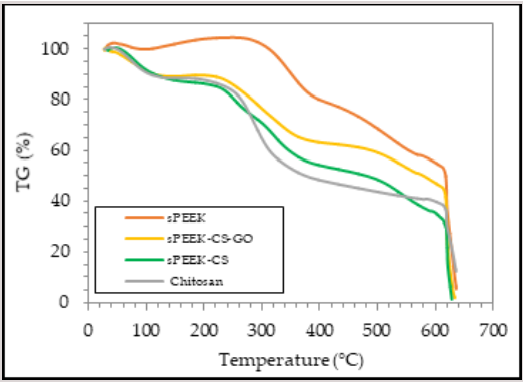Main Article Content
Abstract
Direct Methanol Fuel Cell (DMFC) can operate at low temperatures, but efficiency and performance are greatly influenced by the material. On the other hand, sulfonated ketone polyether ethers (sPEEK) which have high thermal resistance, ductile, chemical resistance and high mechanical properties, can be combined with chitosan which has good proton conductivity properties. The sPEEK-Chitosan membrane is known to have good mechanical and thermal resistance, but its conductivity is low. The addition of graphene oxide as a filler material can increase the proton conductivity due to its properties. This research was conducted with a completely randomized design of 1 factor to investigate the characteristics of the sPEEK-Chitosan composite membrane as the dependent variable and the addition of graphene oxide solution to the variables 0, 1, 3, 6, and 9% w/w as independent variables. The test results show that the water uptake is in the range of 8.82-33.34%, the swelling degree is in the range of 5.55-20.75%, and the ion exchange capacity is 0.1875-0.2714 meq/g. With this good character, the sPEEK-chitosan membrane with the addition of graphene oxide is a promising candidate for DMFC applications.
Keywords
Article Details

This work is licensed under a Creative Commons Attribution-NonCommercial 4.0 International License.
References
- Y. Nuriana, D. Susanti, H. Purwaningsih, and T. M. Atmono, “Analisa Pengaruh Waktu Sputtering Pd dan Ni Pada Sintesis Material Elektrokatalis Berbahan Pd-Ni/Graphene terhadap Uji Kerja Direct Methanol Fuel Cell (DMFC),”Jurnal Teknik ITS, vol. 6, no. 1, pp. B96-B101, 2017.
- N. A. Aini, M. Z. A. Yahya, A. Lepit, N. K. Jaafar, M. K. Harun, and A. M. M. Ali, “Preparation and characterization of UV irradiated SPEEK/chitosan membranes,” International Journal of Electrochemical Science, vol. 7, no. 9, pp. 8226–8235, 2012.
- N. Hidayati, M. Mujiburohman, H. Abdillah, T. Harmoko, and R. D. Arimurti, “Sintesis dan Karakteristik Membran Komposit Akrilonitril Butadiena Stirena (ABS) -Kitosan Tersulfonasi untuk Direct Metanol Fuel Cell,” Jurnal Matematika dan Sains, vol. 22, pp. 20–23, 2017.
- L. Cui et al., “Novel sulfonated poly (ether ether ketone)/silica coated carbon nanotubes high-performance composite membranes for direct methanol fuel cell,” Polymers for Advanced Technologies, vol. 26, no. 5, pp. 457–464, 2015.
- I. Sofia, H. Murdiningsih, and N. Yanti, “Pembuatan dan Kajian Sifat-Sifat Fisikokimia , Mekanikal , dan Fungsional Edible Film dari Kitosan Udang Windu,” Jurnal Bahan Alam Terbarukan, vol. 5, no. 2, pp. 54-60, 2016.
- M. Roza, Gusnedi, and Ratnawulan, “Kajian Sifat Konduktansi Membran Kitosan pada sBerbagai Variasi Waktu Perendaman dalam Larutan Pb,”Pillar of Phisics, vol. 1, no. April, pp. 60–67, 2013.
- N. Shaari. and S. K. Kamarudin, “Characterization Studies of Sodium Alginate/Sulfonated Graphene Oxide Based Polymer Electrolyte Membrane for for Direct Methanol Fuel Cell,” Malaysian Journal of Analytical Sciences, vol. 21, no. 1, pp. 113–118, 2017.
- Y. Heo, H. Im, and J. Kim, “The effect of sulfonated graphene oxide on Sulfonated Poly (Ether Ether Ketone) membrane for direct methanol fuel cells,” Journal of Membrane Science, vol. 425–426, pp. 11–22, 2013.
- A. P. Enggita and E. Santoso, “Pengaruh Komposisi terhadap Perilaku Membran Komposit PVA/Kitosan/Grafin Oksida yang Terikat Silang Trisodium Sitrat,” Jurnal Sains dan Seni ITS, vol. 4, no. 2, pp. 1–5, 2015.
- R. Yee, K. Zhang, and B. Ladewig, “The Effects of Sulfonated Poly(ether ether ketone) Ion Exchange Preparation Conditions on Membrane Properties,” Membranes, vol. 3, no. 3, pp. 182–195, 2013.

